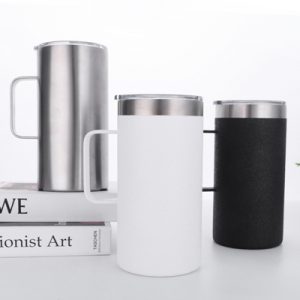Mug means a cup with a large handle. Because the English name of a mug is mug, it is translated into a mug. Mug is a general term for ceramic mug with a handle, but it is not entirely a ceramic mug, because in addition to common ceramic materials, mugs also include plastic, glazed porcelain, stainless steel, glass, etc. There are the following differences from ordinary white porcelain cups:
Material difference: The volume of the ceramic cup is similar to that of the mug, but it can be large or small. The materials of the ceramic cup include bone china, magnesia strengthened porcelain, white porcelain, and stoneware. Our most common ceramic cups are mainly made of white porcelain and strengthened porcelain.
The materials of the mug include porcelain, glass, plastic and stainless steel. Among them, mugs made of the most high-end bone china have the best quality.
Characteristic difference: The ceramic cup made of bone china is lead-free, cadmium-free, and radiation-free. It is known as “thin paper, sound like exhausted, white like jade, and bright like a mirror”. The texture of the ceramic cup is light, dense and hard. It is not easy to wear and tear, has moderate light transmittance and heat preservation, and has a natural milky white color unique to natural bone meal. It is an environmentally friendly green consumer product.
The mug contains more than 40% high-value natural animal bone meal, which is thinner than ordinary ceramic cups, and has a special sense of cleanliness visually, and its strength is 2-3 times higher than that of ordinary ceramics.
Performance difference: Some mugs are designed to be directly used in microwave ovens and placed in dishwashers, but there are a few special cases that need to be used and maintained according to the manufacturer’s instructions. Since the heating principle of the microwave oven is the same, the enamel cannot be put into the microwave oven. When the microwave oven is heated, it will generate electric sparks and reflect microwaves, which will produce electronic eddy currents. However, special containers such as heat-resistant glass and heat-resistant ceramics specially designed for microwave ovens are possible. One thing is to be careful not to put the porcelain cup or bowl with metal rim (don’t put it as long as it can reflect), otherwise there will be sparks, which will cause great damage to the microwave oven.
Style difference: Compared with mugs, ceramic cups are retro and traditional in shape. Many classical elements such as fish, insects, birds and beasts, landscapes and flowers are very popular among business people and elders. The mug has rich shapes and diversified colors. The mug body can be designed into different shapes such as animals, plants, and animated characters. The handle also has a large ring, a small ring, and even a split ring.















